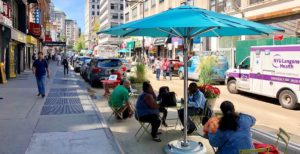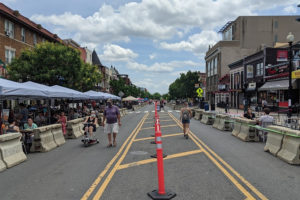THE LEAFLET

What are ‘Streateries’ and Why They’re Good for Urban Trees and Greenspace
Photo courtesy Ted Eytan / Flickr
You may or may not have heard of ‘streateries’ (street eateries) – a pandemic fueled concept where restaurants, looking for space to serve customers while following social distancing regulations, expand their outdoor seating into spaces previously dedicated to sidewalks, parking spots, or even roadways. Here in DC, this phenomenon is best showcased by the opening up of 18th Street NW in Adams Morgan.

Streateries in Brooklyn, NY. Photo Courtesy Downtown Brooklyn Partnership
The only challenge with these streateries? As anyone who has stood on the sidewalk in DC in the summer waiting for a friend, a ride, or a bus knows, it gets hot and stifling. Enter a tried and true business tactic: trees! Streateries are helping call attention to a whole host of built environment conundrums – how much space is dedicated to cars, accessibility of restaurants, and the need for green infrastructure to cool everything off. When dining outside, you need nature’s air conditioner – trees!

18th Street NW when it was closed to cars. It has since reopened, but the expanded restaurant space (know as a streatery) has remained. Photo courtesy Chad Meyers.
Ok, so even if you are not familiar with the newfangled word streatery, other aspects of the ongoing pandemic are calling attention to the importance of easily accessible, well maintained, and shaded greenspace. Afterall, it’s undeniable that citywide park usage this spring and even summer has sharply increased as people head outside. An unprecedented number of folks and kids are at home and everyone needs a break now and then, plus spending time in nature provides well documented mental and physical benefits.
Luckily there are easy ways these days to ensure that trees, streets, and parks are getting the resources they need to support greenspace in the built environment:
- We challenge you to visit a new to you park in August and tell us what you think. How is it different from your usual park? What do you like or don’t like about it? Is there something this park has that you think would be good in your park? Is there something your park has that you think could benefit the park you visited? These thoughts can be tree related or not!
- Businesses can take advantage of our residential planting programs to work with our professional arborists to select and plant trees on their property for free.
- If you see a sad, young street tree with an empty watering bag (that green bag at the base), fill it up! Watering during hot summer months is the best way to ensure young street trees’ survival so they can cool you at a restaurant or shop later in life.
- If you see an empty tree box, submit a Street Tree Planting Request through 311 so a city arborist knows residents want a tree there.
Ultimately, this push outdoors by people and businesses highlights the importance of green infrastructure, trees, and greenspaces in cities – especially as DC’s heat breaks records this summer and shows no sign of cooling off. Greenspaces help residents combat stress, anxiety, and depression. It’s shown that tree-lined streets have a traffic calming effect, which keeps drivers and pedestrians safe. Also, exposure to trees and nature aids concentration by reducing mental fatigue. Why not take action for more of that?